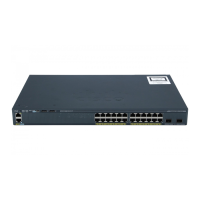39-19
Catalyst 2960 and 2960-S Switches Software Configuration Guide, Release 15.0(1)SE
OL-26520-01
Chapter 39 Troubleshooting
Using TDR
Using TDR
• Understanding TDR, page 39-19
• Running TDR and Displaying the Results, page 39-19
Understanding TDR
You can use the Time Domain Reflector (TDR) feature to diagnose and resolve cabling problems. When
running TDR, a local device sends a signal through a cable and compares the reflected signal to the initial
signal.
TDR can detect these cabling problems:
• Open, broken, or cut twisted-pair wires—The wires are not connected to the wires from the remote
device.
• Shorted twisted-pair wires—The wires are touching each other or the wires from the remote device.
For example, a shorted twisted pair can occur if one wire of the twisted pair is soldered to the other
wire.
If one of the twisted-pair wires is open, TDR can find the length at which the wire is open.
Use TDR to diagnose and resolve cabling problems in these situations:
• Replacing a switch
• Setting up a wiring closet
• Troubleshooting a connection between two devices when a link cannot be established or when it is
not operating properly
Running TDR and Displaying the Results
When you run TDR on an interface, you can run it on the stack master or a stack member.
Note Stacking is supported only on Catalyst 2960-S switches running the LAN base image.
To run TDR, enter the test cable-diagnostics tdr interface interface-id privileged EXEC command:
To display the results, enter the show cable-diagnostics tdr interface interface-id privileged EXEC
command. For a description of the fields in the display, see the command reference for this release.
Using Debug Commands
These sections explains how you use debug commands to diagnose and resolve internetworking
problems:
• Enabling Debugging on a Specific Feature, page 39-20
• Enabling All-System Diagnostics, page 39-21
• Redirecting Debug and Error Message Output, page 39-21

